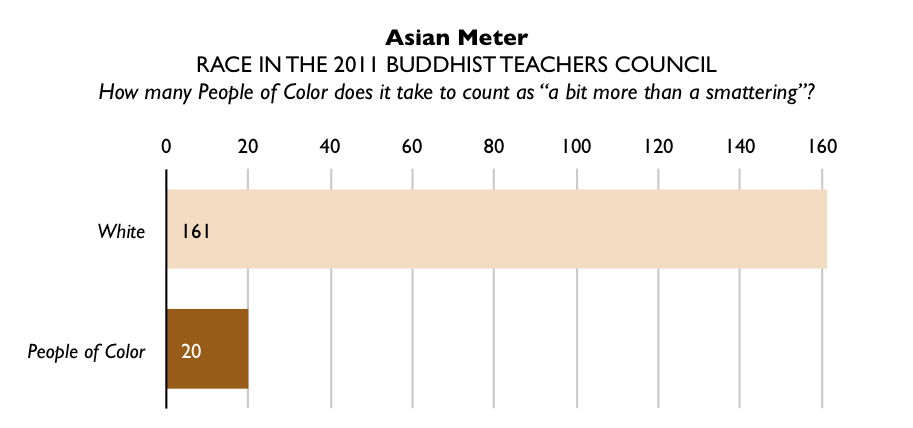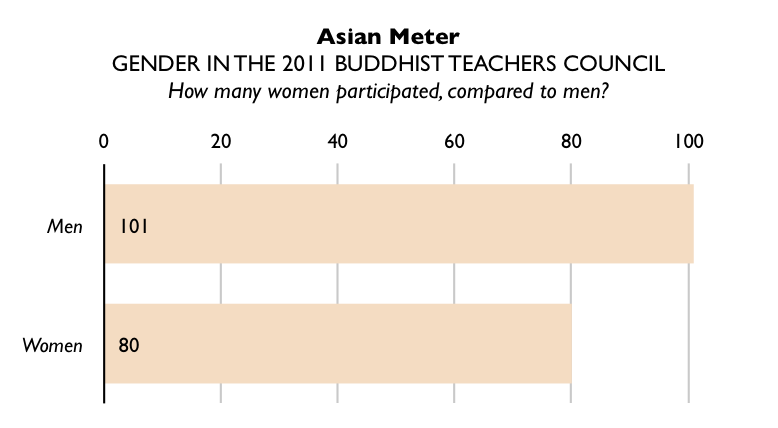Update: The post below is a response to the numbers in a Huffington Post article on racial diversity in American Buddhism. The numbers in the article have since been vetted and revised to address the issues raised.
I encourage you to read Jaweed Kaleem’s most recent Huffington Post article, “Buddhist ‘People Of Color Sanghas’: Diversity Efforts Address Conflicts About Race Among Meditators.” This is a fantastic piece about People of Color sitting groups. Kaleem did some great on-the-ground research and interviews, but when it comes to some of the numbers he presents, there are two important points I’d like you to keep in mind.
First, the numbers are wrong. Kaleem repeats figures from the Pew Forum’s U.S. Religious Landscape Survey that “[American] Buddhism is made up largely of white converts, who count for more than half of U.S. Buddhists; less than one in three are Asian.” These figures struck many as surprising back when the survey was published, and after closer inspection it turns out the numbers were off. As I have pointed out, the Pew study estimated the number of Asian Americans to be half the U.S. Census’ estimate for 2007, thus undercounting the number of Asian American Buddhists.
Fortunately, the Pew Forum has since conducted a survey focused on Asian Americans. Its report on religion (“Asian Americans: A Mosaic of Faiths”) puts the number of American Buddhists at a total of 3–4 million of whom over two-thirds are Asian American. The study estimates that more than one in three Asian American Buddhists meditate at least weekly, so that means there are at least 650,000 Asian Americans who meditate. Imagine if everyone in Boston were an Asian meditator!
Secondly, be aware that Kaleem misinterprets some of the numbers in the Mosaic of Faiths report. For example, he writes:
Studies have shown that most Asian-American Buddhists don’t meditate. Instead, they practice the faith by venerating ancestors, spiritually observing holidays such as Lunar New Year and practicing yoga, and they believe in nirvana and reincarnation.
In this instance, Kaleem presents a divergent inference where there was no basis to do so (i.e. Asian Americans venerate ancestors, observe holidays and practice yoga instead of meditating). All the Pew study told him was that 56% seldom or never meditate; in fact only 38% of Asians never meditate, while the rest report they meditate to some degree. The report doesn’t clarify how many Asian Americans identify as meditators, and it’s not clear if the other practices are viewed as alternatives or complements. It’s conceivable that some of those who meditate also venerate ancestors and observe holidays. At least I do.
A comparison of both studies suggests that Asians probably aren’t engaging in other practices at the expense of meditation. I compared the rates of meditation, prayer and service attendance in the U.S. Religious Landscape Survey of all Buddhists and the Mosaic of Faiths report of Asian Buddhists. All Buddhists turn out to be more likely to meditate weekly (61%), pray daily (45%) or attend weekly services (17%) than Asian Buddhists (34%, 29% and 12% respectively). That disparity suggests that non-Asian American Buddhists meditate, pray and attend services at higher rates than Asians do. More importantly, while Asian Americans appear to meditate less than non-Asian Americans, they aren’t taking up extra prayer or service attendance in its place.
Asian American Buddhists also don’t appear to be shifting their spiritual focus from practice into the realm of belief. When I compared belief in Nirvana, it again turns out that all Buddhists (62%) are more likely to believe in it than Asian American Buddhists (51%). So again, it’s not as simple a story of white Buddhists meditate more while Asian Buddhists do more _____ instead.
Very little of Kaleem’s article has to do with the numbers—just two background paragraphs in fact. But these numbers are still important. Through his interpretation of the survey data, Kaleem perpetuates the stereotype that Asian Americans Buddhists basically don’t meditate much and instead preoccupy themselves with ritual and superstition. A closer look at the data, however, suggests that Asian American Buddhists simply participate less in some of the key rituals and beliefs which strongly characterize non-Asian American Buddhists.
The article speaks much more to the often invisible Buddhists of Color who are not Asian. Kaleem’s interviews weave together an illuminating perspective into the dynamics of People of Color sitting groups, which are just a drop in the bucket that is the American meditation scene. From my experience at just one of these sitting groups, they fill an important gap in the meditation landscape between temples with a strong focus on the needs of Asian immigrant communities and meditation centers rooted in the normative assumptions of white Americans. If you have never heard of these groups, hopefully reading the article will help you understand how they can be such important gateways to the Dharma.
I just hope that in future articles, Kaleem spends a little more time double-checking his numbers.
(Photo credit: Wonderlane)

